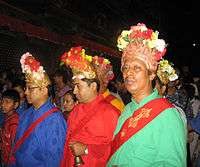Vajracharya
A bajracharya or vajracharya (lit. "vajra acharya (guru or master)") is a Vajrayana Buddhist priest among the Newar communities of Nepal and a Revered Teacher who is highly attained in Vajrayana practices and rituals. Vajracharya means "vajra carrier". They are also commonly called guru-ju or gu-bhaju (a short form for guru bhaju) which are Nepali terms related to the Sanskrit term guru, and translate as "teacher" or "priest". The bajracharya is the highest ranking of the Newar castes that are born Buddhist.[1]

| Part of a series on |
| Vajrayana Buddhism |
|---|
 |
|
Traditions Historical traditions:
New branches:
|
|
History |
|
Pursuit |
|
Practices
Fourfold division: Twofold division: Thought forms and visualisation: Yoga:
|
|
Festivals |
|
Tantric texts |
|
Ordination and transmission |
The emergence of vajracharya institution is ascribed to the decline of celibate Buddhist monks in about 13th century, and the emergence of Vajrayana.[2]
To become a professional Guruju, a person of the bajracharya caste must go through a number of rituals. The bajracharya boy goes through a ritualistic process of initiation known as bajravishekha,[3] including shaving off the head as the buddha and asking for alms, at a minimum of seven houses a day in different places, in the tradition of monks since the time of Gautama Buddha. Sometimes tantric Newar Buddhism and Esoteric Buddhism is referred to as "Vajracharya Buddhism".
The writers of Rebuilding Buddhism: The Theravada Movement in Twentieth-century Nepal explore the unusual relationship of the vajracharyas and their assistant shakyas with Buddhist monasticism:
Unlike Vajracharyas, Shakya men may not be priests for others, but together with Vajracharya men they are the members of the traditional Newar Buddhist monasteries, known honorifically as vihara and colloquially as Baha or Bahi. In so far as Shakya and Vajracharya men filled their roles in the monastery, they were monks. In effect, they were married, part-time monks.[4]
Many of the modern Buddhist scholars in Nepal belong to the vajracharya tradition.[5] There are several legendary vajracharya priests from different parts of Kathmandu valley. Shatikaracharya, a king who turned into a powerful tantric priest and disappeared inside the cave in Shantipur Swoyambhu is well known for his expertise in vajrayana buddhist practice. He is still believed to be dwelling inside the Shantipura cave performing intense sadhana. Vajracharya Bandhudutta, who was a disciple of the legendary Shatikaracharya, is credited with bringing lord lokesvara form kamaru kamakhya Askam, in Kathmandu valley. Leela Vajra, a Buddhist priest from sakhu is believed to have built kasthamandap from the wood obtained from kalpabrikshhya ( wish fulfilling tree) Similarly Surata Vajra, Vak Vajra, Sashwot Vajra, Manjuvajra ( Jamana Gubhaju) etc. are some of the famous Vajracharya priests whose folklores of magical and mystical deeds are popular among the people of Kathmandu valley
See also
References
- Hattaway, Paul (2004). Peoples of the Buddhist World: A Christian Prayer Diary. William Carey Library. p. 198. ISBN 0-87808-361-8.
- A History of Nepal, John Whelpton, Cambridge University Press, 2005, p. 30
- "A Brief Introduction of Distinctive Features of Nepalese Buddhism". 2002. Retrieved 2008-07-27.
- Sarah LeVine, David N. Gellner (2005). Rebuilding Buddhism: The Theravada Movement in Twentieth-century Nepal. Harvard University Press. p. 37. ISBN 978-0-674-01908-9.
- The Circle of Bliss: Buddhist Meditational Art, John C. Huntington, Dina Bangdel, Robert A. F. Thurman, Los Angeles County Museum of Art, Columbus Museum of Art, Serindia Publications, Inc., 2003, p. 12
Further reading
- Gellner, David N. (1992). Monk, Householder, and Tantric Priest: Newar Buddhism and its Hierarchy of Ritual (Cambridge Studies in Social and Cultural Anthropology). Cambridge University Press. ISBN 978-0-521-38399-8.
- Revisiting Rituals in a Changing Tibetan World, Brill, Leiden, 2012.
External links
